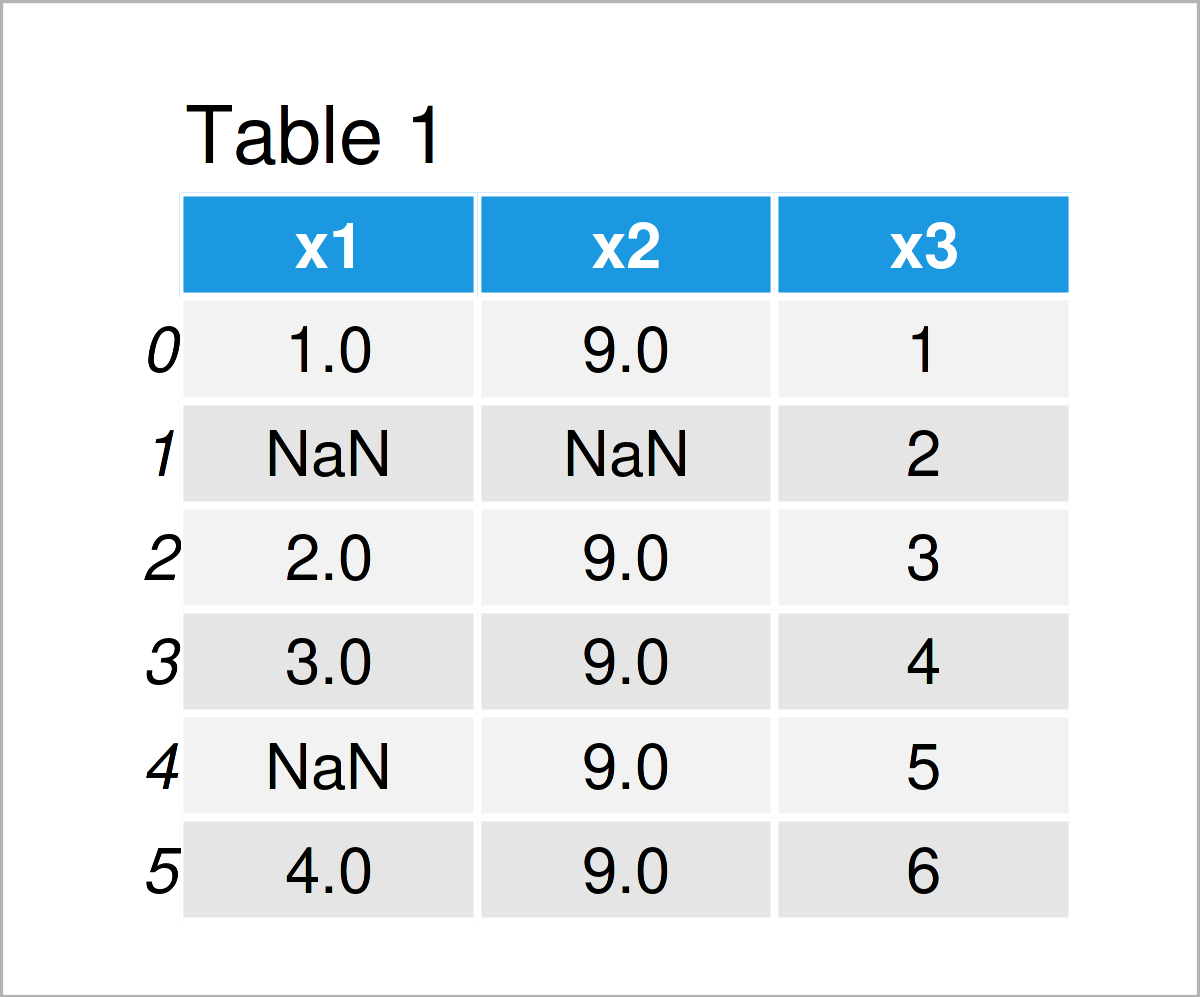Count NaN Values in pandas DataFrame in Python (5 Examples)
In this tutorial you’ll learn how to get the number of NaN values in a pandas DataFrame in Python programming.
The post looks as follows:
Let’s get started…
Example Data & Libraries
We first have to load the pandas library, in order to use the functions that are included in the library:
import pandas as pd # Import pandas library to Python
We’ll use the following data as basement for this Python tutorial:
data = pd.DataFrame({'x1':[1, float('NaN'), 2, 3, float('NaN'), 4], # Create DataFrame 'x2':[9, float('NaN'), 9, 9, 9, 9], 'x3':range(1, 7)}) print(data) # Print example DataFrame

Table 1 shows the structure of our example data: It is made of six rows and three columns called “x1”, “x2”, and “x3”. Some of the variables in our data set contain NaN values (i.e. Not a Number).
Example 1: Count NaN Values in All Columns of pandas DataFrame
In Example 1, I’ll explain how to return the number of NaN values in each column of a pandas DataFrame in Python.
For this, we can use the is.na and the sum functions as shown below:
print(data.isna().sum()) # Number of NaNs by column # x1 2 # x2 1 # x3 0 # dtype: int64
Have a look at the previous console output: It shows that our first column x1 contains two NaN values, the second column x2 contains one NaN value, and the third column x3 contains no NaN values.
Example 2: Count NaN Values in One Specific Column of pandas DataFrame
Example 2 explains how to count the NaN values in a single DataFrame column.
The following Python code returns only the amount of NaNs in the column x1:
print(data['x1'].isna().sum()) # Number of NaNs in one column # 2
As you can see based on the previous output, the column x1 consists of two NaN values.
Example 3: Count NaN Values in All Rows of pandas DataFrame
The following code shows how to count NaN values row wise.
To do this, we have to specify the axis argument within the sum function to be equal to 1:
print(data.isnull().sum(axis = 1)) # Number of NaNs by row # 0 0 # 1 2 # 2 0 # 3 0 # 4 1 # 5 0 # dtype: int64
The row with the index position 1 contains two NaN values and the row with the index position 4 contains one NaN value. The other rows do not contain any NaN values.
Example 4: Count NaN Values in One Specific Row of pandas DataFrame
This example illustrates how to extract the number of NaN values only for one row by subsetting this row by its index position:
print(data.loc[[4]].isna().sum().sum()) # Number of NaNs in one row # 1
The row with the index position 4 contains one NaN value.
Example 5: Count All NaN Values in Entire pandas DataFrame
In this example, I’ll explain how to count all NaN values in the whole pandas DataFrame.
For this, we have to apply the sum function twice:
print(data.isna().sum().sum()) # Number of NaNs in entire DataFrame # 3
Overall, three cells of our pandas DataFrame are NaN.
Video, Further Resources & Summary
Still questions? I have recently released a video on my YouTube channel, which shows and explains the Python syntax of this article. You can find the video below:
In addition, you can also have a look at the following video on the YouTube channel of Minsuk Heo. He demonstrates how to check NaN and replace it in the video instruction.
Furthermore, you might read the related tutorials on my website.
- Handling DataFrames Using the pandas Library in Python
- Replace NaN by Empty String in pandas DataFrame in Python
- Check If Any Value is NaN in pandas DataFrame in Python
- Replace NaN with 0 in pandas DataFrame in Python
- Remove Rows with NaN from pandas DataFrame in Python
- Replace NaN Values by Column Mean in Python
- Introduction to Python Programming
At this point you should have learned how to count the number of NaN values in a pandas DataFrame in Python. In case you have any further questions, don’t hesitate to let me know in the comments.






